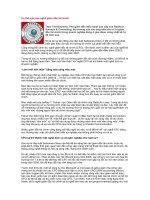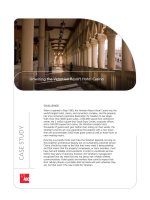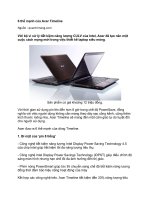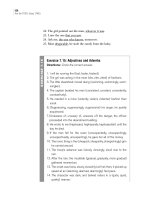Tài liệu Do the Standards go far enough? doc
Bạn đang xem bản rút gọn của tài liệu. Xem và tải ngay bản đầy đủ của tài liệu tại đây (327.77 KB, 4 trang )
===
=
=
=
WHITE PAPER
1 of 4 pages
=
Do the Standards go far enough?
Current position and focus of Standards versus
what we now know regarding component matching.
For some time now we have had ratified standards throughout the world relating
to generic, or structured cabling. We have seen progress from the initial Category
3 cable and connectors, to Category 4 albeit very briefly, to Category 5 where we
are today. We have also seen a shift of emphasis from component specifications
to link and channel specifications which is somewhat more meaningful to the end
user.
In more recent times we have seen many drafts of Cat. 5, or Cat 5e, Category 6
and 7. All of these specifications focus heavily on
bandwidth
, with progression
from 16 MHz for Cat 3, to 20 MHz for Cat 4 and for Cat.5 or Cat. 5e still focuses
on 100MHz of bandwidth, with some parameters tightened and some new
parameters added. Category 6 doubles this bandwidth to 250 MHz, so it is a
quantum leap over Cat 5/ Cat 5E. Category 7, if it ever comes to fruition, takes a
further giant leap to 600MHz, however it will be a heavily screened solution with
possibly non-RJ45 connecting hardware.
As previously mentioned, we have seen many drafts of both Cat 5e and Cat 6,
but the actual ratified published versions seem to be forever coming but never
arriving. In fact, as this paper is being written, we are up to draft 11 of Cat.6! So
why the delay? Well, a couple reasons come to mind. Firstly, and most
importantly, there is an ongoing problem with a relatively new parameter called
return loss.
Return loss is a signal
echo
resulting from inconsistencies in the
channel structure, mainly due to poor component impedance matching. The
other reason is that it is no easy feat to produce a Category 6 jack that performs
adequately at 250MHz and that remains backwards compatible with Cat 5e patch
cords.
===
WHITE PAPER
2 of 4 pages
Return Loss (RL)
Let me come back to the issue of Return Loss (RL). For some time now the
standards bodies have been aware of the problem of poor performance of patch
cords when introduced to the
basic link
(which then becomes the
channel).
Now
we have the hard evidence to support this concern.
KRONE have identified this problem and the effect on the channel, particularly
the data through-put, through the use of a new test instrument called the
Le Croy
Newsline.
This device has the ability to check both passive and active channels,
and when testing active channels has the ability to look at all seven layers of the
OSI model.
In looking specifically at the passive channel, the
Newsline
can show any
impedance anomalies throughout the cabling infrastructure, including the cable,
connectors and patch cords. Published standards specify components at 100
Ω
+/- 15
Ω
, which includes cable both solid and stranded, connectors and
plug/socket assemblies. The problem comes about from the fact that it appears
===
WHITE PAPER
3 of 4 pages
this impedance spread is too broad, resulting in excessive mismatches of
components which affects data throughput on today’s high speed networks. The
diagrams below illustrate this point.
All components in the above diagrams are standards compliant, however the
return loss introduced by the
signal reflections
seriously distorts data signals
leading to excessive bit error rates (BER’s), resulting in re-transmission of data
packets and an insidious slowing down of your network.
This problem often manifests itself when a company upgrades its network from
10baseT to 100baseT, which uses more complex and less robust data protocols.
The MLT3 encoding used for 100baseT can very quickly degrade due to these
mismatches, resulting in receivers not being able to recognise the signal. CRC
errors become evident and the resultant retransmissions begin to mount. The two
diagrams below are actual traces of the data signal at the transmit end (left
diagram) and the receive end (right diagram). It’s hard to believe they are
supposed to be the same signal, although the right image would be attenuated
somewhat in normal circumstances.
Tuned Individual Pairs Within The Cable
KRONE have solved this problem. We have truly
matched
the cable and
connectors, and also
tuned
the individual pairs within the cable to ensure a
much tighter impedance spread. The obvious resultant benefit is less return loss
therefore less signal degradation, significantly improving network performance.
Even the match of the Network Interface Card (NIC) to the cable plant is
improved by this tighter tolerance, often proving to be the saviour of a
marginal
NIC that may otherwise be discarded and replaced.
===
WHITE PAPER
3 of 4 pages
Another excellent feature of the Le Croy Newsline is its ability to look at actual
data signals and transmission speed. Many dual speed cards have indicator
LED’s showing the transmission speed of the link, either 10Mb/s or 100Mb/s. The
Newsline has shown that these LED indicators are not accurate, often indicating
100Mb/s when in reality they are running at only 10Mb/s (sometimes even less!).
Many Network Administrators, when investigating complaints of slow networks,
look at these cards and see the “fast” light on and go off on a wild goose chase to
trouble-shoot their network.
Cabling, on many occasions, accounts for only about 5% of total network costs,
yet is often taken for granted. Money is regularly found for upgrading servers,
software and interface cards in a vain attempt to improve poor data throughput.
Network Administrators assume cable is cable and rarely look the cabling
infrastructure when diagnosing network problems. Similarly, cable experts have a
“blind faith” in the active electronics and rarely give any consideration to the
compatibility of the active equipment to the passive cable plant. The Newsline
evidence strongly suggests that we should be looking at the whole network
concurrently, as this is the only way we can address the compatibility issue
adequately.
Further detailed information
on this issue can be obtained on the at
:www.kroneasia.com









